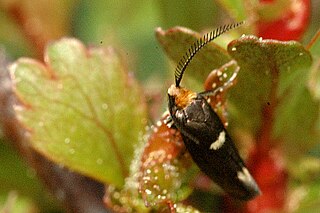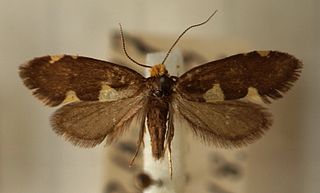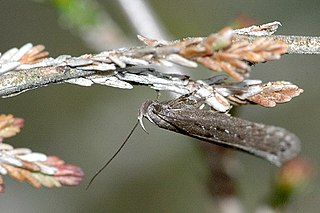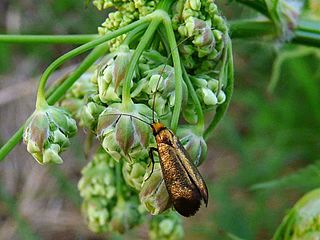
Cauchas rufimitrella is a diurnal lepidopteran from the family Adelidae, the fairy long horn moths. It is found in almost all of Europe, except Portugal, Ukraine and the southern part of the Balkan Peninsula.

Incurvaria masculella, the feathered leaf-cutter, is a moth of the family Incurvariidae. It is widespread in Europe.

Incurvaria oehlmanniella is a moth of the family Incurvariidae. It is found in Europe and across the Palearctic to eastern Siberia.

Incurvaria pectinea is a moth of the family Incurvariidae. It is found in Europe.

Neofaculta ericetella is a moth of the family Gelechiidae. It is found in Europe and Asia Minor.

Recurvaria leucatella is a moth of the family Gelechiidae. It is found in most of Europe, Turkey, Central Asia and the Caucasus.

Anacampsis populella is a moth of the family Gelechiidae, which is native to Europe and has been accidentally introduced to North America. It was first described in 1759 by Carl Alexander Clerck, a Swedish entomologist. The type specimen is from Sweden. The foodplants of the larvae are poplars and willows.

Tischeria dodonea is a moth of the family Tischeriidae. It is found from Fennoscandia to the Pyrenees, Italy and Romania and from Ireland to Ukraine. There is a disjunct population in eastern Russia.

Adela croesella is a moth of the family Adelidae. It is found in most of Europe.

Phylloporia bistrigella is a moth of the family Incurvariidae. It is found in western, northern and central Europe and north-eastern North America.

Nematopogon metaxella is a moth of the Adelidae family. It is found in most of Europe.

Incurvaria praelatella is a moth of the family Incurvariidae. It is found in all of Europe, except the Iberian Peninsula.

Nemophora cupriacella is a moth of the family Adelidae that is found in most of Europe.

Heliozela resplendella is a moth of the Heliozelidae family. It is found from Fennoscandia and northern Russia to the Pyrenees, Alps and Romania and from Ireland to the Baltic region.

Coptotriche marginea is a moth of the family Tischeriidae, found in most of Europe. It was named by the English botanist, carcinologist and entomologist, Adrian Hardy Haworth in 1828, from a specimen found in England. The larvae mine the leaves of brambles (Rubus) species.

Nemophora minimella is a moth of the Adelidae family. It is found in most of Europe, except Estonia, Ukraine, Slovenia, Switzerland and Portugal.

Nematopogon pilella is a moth of the Adelidae family. It is found in almost all of Europe, except Portugal, Spain and Slovenia.

Nematopogon schwarziellus is a moth of the Adelidae family. It is found in almost all of Europe, except Portugal, Slovenia, Croatia, Greece and Ukraine.

Adela cuprella is a moth of the family Adelidae and are found in most of Europe. It was first described by Michael Denis & Ignaz Schiffermüller in 1775 and the type locality is from Austria. They can be found flying around sallows (Salix) species during the day in April and May.

Heliozela sericiella is a moth of the Heliozelidae family found in Europe. The larvae mine the twigs of oaks, causing a gall.




















